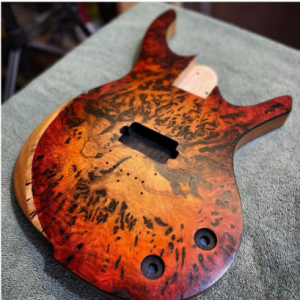THIS MAY BE OF HELP TO SOME
From a customer:
I recently purchased the Hard shellac to go over the water dyes also bought from you. I have 3 questions that I couldn’t find answers for on the product or on your website.
- Me: ONLY 3… why so few? (Sorry couldn’t help my self).
1. How long do I have to wait for the water dye to dry before applying the Hard Shellac?
- That will depend on the wood used, humidity, and anything else that could affect the drying time ideally to be sure it’s properly dry overnight but may only need an hour or so in warm conditions. If you apply the shellac too early and there is still moisture in the wood from the dye, you may get blooming of the shellac. Looks like a bit milky. This should disappear with another coat of the shellac
2. Can I apply the Shellac with a cloth as it is for a guitar?
- Ideally for a guitar French polishing would give the best result. I would be very wary of just raging it on. If you can’t French polish, go to an art supply shop and get yourself a camelhair artists water colour mop approx. 25mm. This has very fine bristles and will hold as much if not more polish than a 100mm brush off the shelf at a paint shop. These brushes do not leave brush marks in the finish.
3. How long do I wait between coats of Hard Shellac?
- If you’re French polishing you can recoat as soon as the surface is dry to the touch anywhere from a few minutes to an hour depending on weather conditions.If brushing recoat when the surface is dry to the touch this will be much longer than French polishing as the brush will add a much heavier coat. There should be no need to sand between coats for either method unless you make a mess of it.
A little warning. Before applying the dye… it’s a good ide to apply a single coat of our
Sanding Sealer,* this will raise any grain torn but the sanding and make them stand up and become brittle. Leave it to dry and with your finest grit abrasive 1200 or higher, wipe over the dried sealer to remove the raised nibs.
DO NOT SAND! JUST WIPE OVER WITH THE ABRASIVE. This will remove the nibs without raising the grain again as would happen if you sand instead of wipe.
If you do not do this first the water dye may raise the grain causing a problem as it would either have to be sanded back, thus lightening the colour and giving a blotchy appearance if left or stained again, or you would end up with a finish that felt like someone had thrown a handful of sand onto the surface.
If you use the sealer as above, the dye will be able to penetrate through the sealer and into the wood and should give an even colour without raising the grain.

Last but definitely not least least:
Before you do anything, practice on a separate scrap piece of the same or similar wood if solid body guitar or on the same veneer if it’s acoustic, to make sure you are happy with the result. This could save a few tears and gnashing of teeth, down the track.
Hope this is of help.
* If you already have some of our
White Shellac (Dewaxed) you can mix 8 to 10 parts of metho with a portion of it and that will give you sanding sealer. If your White shellac is out of date you can mix what you have left of it as above and will give you sanding sealer for many years to come.


Leave a Reply